Rotating Meats when Feeding Raw or Homemade Diets #ad
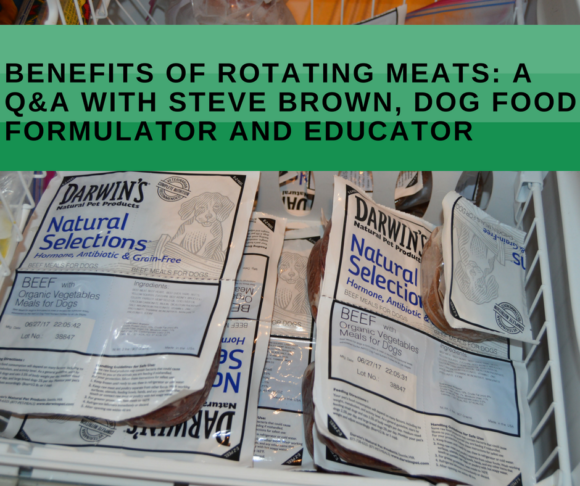
Rotating from chicken to beef when you’re feeding raw? Are there advantages to this rotation pattern with your dog’s food? #ad #sponsored
There are benefits to rotating meats – dog food formulator and educator, Steve Brown explains, “Alternating from beef to poultry changes the fats consumed, that’s a big difference, and one example of why rotation is important. Changing brands and animal meat sources for dry foods is equally important.”
Steve recommends rotating poultry, such as chicken, duck, quail and turkey, and ruminants, which includes cattle, sheep, and deer.
I’m not an expert in nutrition (clearly!) but I know all three of my dogs are healthy and super happy when it comes to their meals and we’ve been feeding Darwin’s Raw Diet for years and rotating meats You can find more here about my review of Darwin’s and the introduction of Lamb this year here.
Prior to feeding a raw diet, rotating meats went against everything I’d learned or read in the past ten years so I was thrilled to talk to Steve about this topic. Currently, we switch between chicken, beef, bison and lamb every few days. Now these are all meals from Darwin’s so I’m not arbitrarily switching kibbles. I want to make that super clear. Steve talks about transitioning to raw diets from kibble here. Since our dogs are eating a raw diet rotating between meats is fine and the frequency doesn’t matter.
A Q&A on rotating meats:
Haven’t heard of Steve Brown? – He is a renowned dog food formulator and educator who has been in the raw dog food industry since its start. He’s been called the Godfather of Raw Dog by many, but is most known for his book “Unlocking the Canine Ancestral Diet” and “See Spot Live Longer.”
Steve focuses on real foods so I asked him some questions I think readers want to know:
“Take everything you know about dog food, and throw it away!” is where my interview with Steve starts.
Q. Can we talk about some examples of why rotating meats makes a lot of sense? *FYI: Darwin’s is balanced and you don’t have to worry about any nutrient deficiencies – but below is good information for folks generally speaking, those that feed a fresh food diet and raw. This is a very high level overview – Steve wrote an entire blog post here.
Rotating meat sources improves the balance of:
- fatty acids
- minerals
- vitamins
- amino acids
Example #1: – Let’s start with fatty acids as this is the most important reason to rotate:
One example of many: LA, an omega-6 fatty acid, is crucial and amounts vary with different meat sources, so if we rotate poultry with ruminant, we get an improved balance of fats. As Steve likes to say “the dog is the fats she eats.”
The numbers don’t lie: Lean, commercial-quality beef contains about 1.5 g of LA per 1000 kcal (what a typical 40-pound dog consumes daily), grass-fed beef about 2.2 g. The recommended minimum for growth is 3.3, 2.8 for adult. Lack of LA has been linked to skin and coat problems. Poultry meats contain lots of LA, typical dark meat contains 14.4 g, and light meat, depending how much skin is fed, about 10. High fat poultry meats can contain too much LA, which may be pro-inflammatory.
“When feeding just ruminant foods, we are concerned about not getting enough LA, an omega-6 fatty acid and the first fatty acid to be considered essential, and ALA, an omega-3 fatty acid. When feeding only poultry meats, we are concerned about too much LA, (that’s why we use lean poultry meats), and not enough ALA.”
Example #2: Minerals & Vitamins (we’re looking at Cooper in this example)
Beef liver contains almost 20 times more copper than chicken liver, according to the USDA nutrient database. Copper is essential in small amounts, and can be detrimental to health in large amounts. “Beef recipes, with liver, have ample copper. The chicken recipes need additional copper. If you are rotating, one day beef with beef liver, and the next day chicken, your dog will be getting the proper amounts of copper. Rotate every 1 to 3 days.
For those making their own foods, and feeding only poultry, you need to add copper, either through whole foods (best) or supplement. If you can, add mussels for copper and manganese (another crucial mineral often lacking in homemade diets), and oysters for zinc and copper. More details in these blog posts about copper, manganese and zinc blogs.
Steve explains that by rotating meats you can ensure you get the proper amount of minerals overall and when it comes to specific minerals like copper – you want to keep in mind that switching between beef and poultry is crucial to you get that proper balance.
Example #3: Vitamins
B12 is an essential vitamin. Poultry muscle meats usually do not contain sufficient vitamin B12 to meet standards, one needs to add the organs for the B12. Beef meats contain ample B12, about 7 times more than comparable fat content chicken meats.
Example #4: Amino Acids –tryptophan (has a calming factor)
Chicken, duck, pheasant have more tryptophan.
As most of us know, turkey and chicken are high in tryptophan, an essential amino acid (proteins consists of long chains of amino acids). On the other hand, even moderately fatty beef may be low in tryptophan. Indeed, some homemade and commercial beef diets, using moderately fatty beef, and fall short of minimum recommendations for tryptophan. For dogs, lack of tryptophan in high protein diets may lead to aggressive behavior. Lean (skin and separable fat removed) chicken and turkey breast have about 2.5g of tryptophan per 1000 kcal, while the equivalent leanness beef has about 0.8g of tryptophan per 1000 kcal. It’s important to rotate.
Amino Acids Profile – based on adults (not growth) and looks at:
- 80% lean beef
- Whole chicken with skin
*AAFCO 2016 (vet journals)
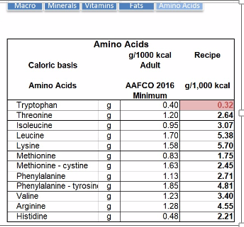
80% Beef
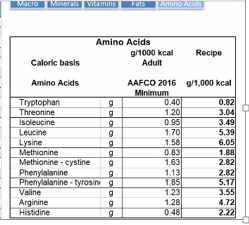
Whole chicken with skin
Q. Is there any downside to doing this as far as GI upset?
“A valid question: the issue is having the right gut microbes – so you introduce raw diets (varying meats) slowly – these microbes are necessary to process real foods – and these will thrive over about ten days at which time the gut will have the proper balance.”
Then you can go from meat to meat without an issue.
*For dogs like Bruiser that have Irritable Bowel Disease (IBD) – you can cook lightly like I do and Steve doesn’t see a huge difference between raw and lightly cooking. Check out this article on why protein-rich diets may help soothe inflamed gut –and why dogs with IBD benefit.
Q4. Any thoughts on raw food and allergies?
I was curious so I asked! – I’m referencing a study that Steve recommended folks review. It was done 15 years ago in Sweden with a litter of Westies. It looks at kibble vs. fresh food and the impact of allergies.
The main finding was that feeding a diet including noncommercial products to the bitch during lactation had a protective effect on the development of CAD in her offspring; the odds of developing CAD were twice as high among offspring from bitches that were not exposed to home-made/noncommercial diets [95% confidence interval (CI) of the odds ratio:1.2–3.8]. The population attributable fraction for notfeeding home-made diets to the lactating bitch was estimated as 0.4 (95% CI: 0.04–0.63). Randomized con-trolled clinical trials are needed to further support the finding of a potential protective role of diet in CAD development.
They key piece Steve adds about this study is this: put in as many real foods as you can with the kibble.
Other advice?
And if the food has things like probiotics and fish oil – forget it, just buy an inexpensive food (kibble) with no extras and add fish oils on your own, and some real food (can of sardines).
Whatever we learned, toss it out.
BIO: Steve Brown is a renowned dog food formulator and educator who has been in the raw dog food industry since its start. He’s been called the Godfather of Raw Dog by many, but is most known for his book “Unlocking the Canine Ancestral Diet” and “See Spot Live Longer.”
Another raw food expert: Keep Your Tail Wagging – also talks about Darwin’s on her blog.
Resources/Further Reading:
Vet Disclaimer: Pet owners who use this site are urged to consult directly with their veterinarian for a pet nutritionist or any medical advice.
Disclaimer: We receive food from Darwin’s as part of their blogger program in exchange for an honest review. I only share information about products that I believe in and already fit into our doggie lifestyle and routine. Darwin’s did not compensate me for this post.
Pin me!
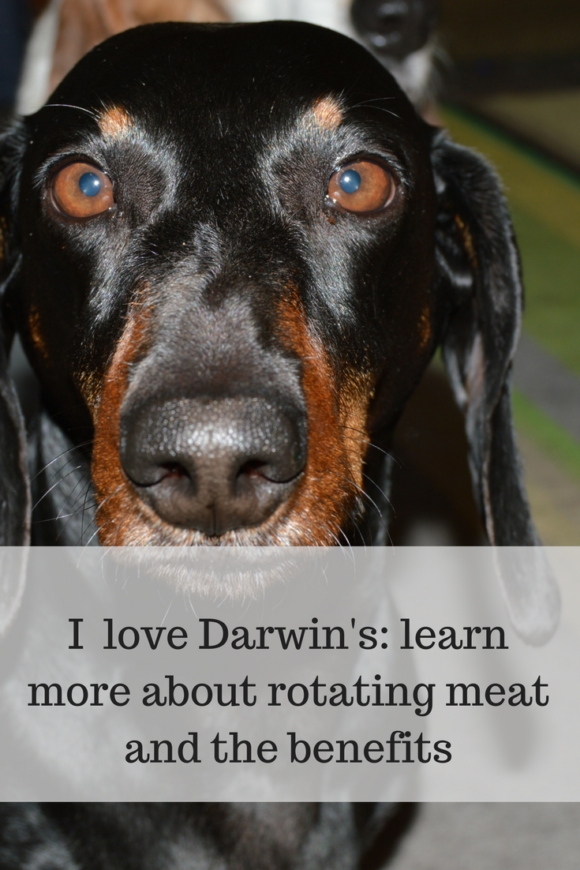
Why Darwin’s

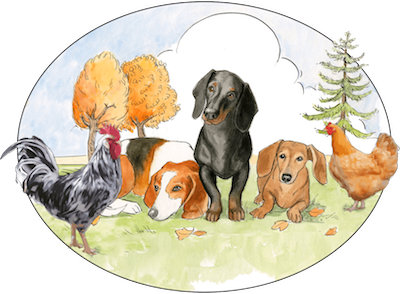

I don’t feed raw but this is really interesting information! I feed largely commercial pet food, both dry & wet, but I sometimes add in food that I cook myself. I’ve always rotated meats & flavors just for variety but it’s nice to see there’s another benefit to rotating the meats. Thanks for sharing!
Love & Biscuits,
Dogs Luv Us and We Luv Them
Thank you! I think it’s really awesome to add in human food to whatever you’re feeding for variety! Before feeding a raw diet I totally did that… I thought the conversation with Steve with really interesting! Happy Friday. 🙂
Very informative post – I just pinned it to my “Raw Feeding” board. I’ve been feeding my guys raw for 2.5 years now and switch between beef, bison, chicken, turkey, duck, and rabbit. I also used to feed lamb but ever since I found out that my girl Missy does poorly on it, lamb is no longer on the menu. I generally try avoiding hot protein sources for her now.
Thank you so much! I’m so glad you found it helpful as I spent a lot of time with Steve Brown and he had a ton of great information but if you’d like more details his blogs on Darwin’s site are very comprehensive. I’ve had to swap in and out some meats as well – like turkey isn’t a great meat for my guys for whatever reason. I think seasonally too I swap in chicken more than beef… Appreciate you commenting!
Darwin’s only has fowl diets for cats. My 2 cats eat the duck & turkey meals. Is there any advantage to rotating their proteins other than on an every-other-day basis?
Thanks so much Leslie: I’m asking expert Steve Brown for his advice – I’ll get back to you asap.
Good question Leslie. Yes, there are some advantages to rotating the duck and turkey meals, perhaps as often as every other day, or as often as every third day or so. With cats, my first concern is “will they eat it?” So I’d go with a rotation schedule that makes sure that your cats eat the food.
Formulating fresh foods for cats is much more difficult than formulating fresh foods for dogs. Dogs will eat almost everything, and we can formulate with nutrition uppermost in mind. With cats, we need to formulate with “will they eat it?” first, then we build the most nutritious food we can.
I hope this helps. Let me know if you have more questions or comments. -Steve Brown